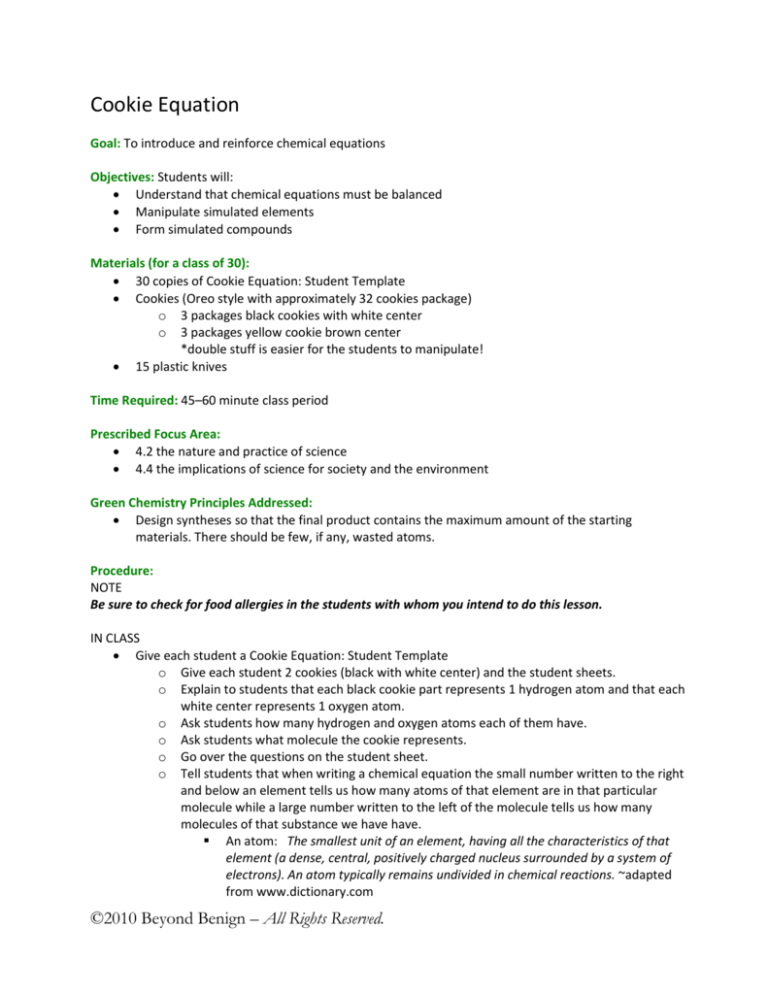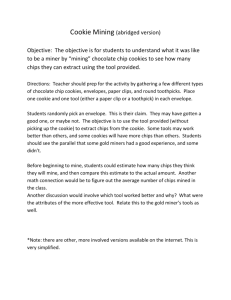
Cookie Equation
Goal: To introduce and reinforce chemical equations
Objectives: Students will:
Understand that chemical equations must be balanced
Manipulate simulated elements
Form simulated compounds
Materials (for a class of 30):
30 copies of Cookie Equation: Student Template
Cookies (Oreo style with approximately 32 cookies package)
o 3 packages black cookies with white center
o 3 packages yellow cookie brown center
*double stuff is easier for the students to manipulate!
15 plastic knives
Time Required: 45–60 minute class period
Prescribed Focus Area:
4.2 the nature and practice of science
4.4 the implications of science for society and the environment
Green Chemistry Principles Addressed:
Design syntheses so that the final product contains the maximum amount of the starting
materials. There should be few, if any, wasted atoms.
Procedure:
NOTE
Be sure to check for food allergies in the students with whom you intend to do this lesson.
IN CLASS
Give each student a Cookie Equation: Student Template
o Give each student 2 cookies (black with white center) and the student sheets.
o Explain to students that each black cookie part represents 1 hydrogen atom and that each
white center represents 1 oxygen atom.
o Ask students how many hydrogen and oxygen atoms each of them have.
o Ask students what molecule the cookie represents.
o Go over the questions on the student sheet.
o Tell students that when writing a chemical equation the small number written to the right
and below an element tells us how many atoms of that element are in that particular
molecule while a large number written to the left of the molecule tells us how many
molecules of that substance we have have.
An atom: The smallest unit of an element, having all the characteristics of that
element (a dense, central, positively charged nucleus surrounded by a system of
electrons). An atom typically remains undivided in chemical reactions. ~adapted
from www.dictionary.com
©2010 Beyond Benign – All Rights Reserved.
A molecule: The smallest particle of a substance that retains the chemical and
physical properties of the substance and is composed of two or more atoms; a
group of like atoms is an element or different atoms is a compound – both are held
together by chemical forces. ~adapted from www.dictionary.com
o Their cookie represents 1 molecule of water composed of two atoms of hydrogen and one
atom of oxygen.
o Two molecules of water (2H2O) could be shown with two cookies made up of 4 hydrogen
atoms and 2 oxygen atoms. Three molecules of water (3H2O) would be shown by 3
cookies made up of 6 hydrogen atoms and 3 oxygen atoms, and so on.
Tell students they are going to now form a chemical reaction.
Explain that in a chemical reaction, whatever elements are on the left side of the equation, will be
in the final product on the right side of the equation. The combinations may be different, but the
amount on the left must equal the amount on the right. “What goes in must come out”. The Law
of the Conservation of Matter states that matter is neither created nor destroyed during the
course of a chemical reaction. Although they may be combined differently the mass of the atoms
in the reactants must equal the mass of the atoms in the product.
Give each student a yellow and brown cookie
Direct students to use their cookies to construct a model of the left side of the equation.
o You may need to refer them to the KEY on the student template
Have a student share his or her model with the class.
Tell students to use their cookies to construct a model of the right side of the equation.
Ask students if there were any cookie parts not used? Why not?
Have students compare and contrast their models from both sides of the equation.
Query students as to their familiarity with these chemical compounds. What are their scientific
names? What are their common names?
o NaOH = sodium hydroxide = lye
o HCl = hydrochloric acid = gastric acid
o NaCl = sodium chloride = salt
o H2O = dihydrogen oxide = water
Discuss toxicity levels of chemical compounds before the reaction, and the toxicity levels after the
reaction.
o Highly toxic before
o Benign after
Explain that this is a neutralization reaction; the highly toxic Sodium Hydroxide and Hydrochloric
acid combine to form the relatively safe compounds of salt and water.
Repeat these steps with the second cookie equation.
o This equation illustrates how methane gas combines with oxygen in the atmosphere to
make carbon dioxide, a key component to the Greenhouse Effect.
Review the principle: Design syntheses so that the final product contains the maximum amount of
the starting materials. There should be few, if any, wasted atoms.
Explain that sometimes chemists make a compound that uses 5 parts to make the reaction, but
only 4 parts bind together to make something useful. That means that the 5th part is a by-product
and is waste. It must be disposed of properly.
In Green Chemistry, the purpose is to avoid these by-products.
Complete the same steps for the final reaction.
©2010 Beyond Benign – All Rights Reserved.
Explain to students that this represents the reaction they can see, hear, and smell when using a
product to unclog a drain, like Drano ®. These products typically consist of aluminum and NaOH.
When combined with water, an exothermic reaction is created.
o Al = aluminum
o NaOH = sodium hyrdroxide
o Na3AlO3 = an aluminate of sodium
o H2 = hydrogen gas
Assessment:
Participation in the activity and discussion
Correct models of the equations
©2010 Beyond Benign – All Rights Reserved.
Cookie Equation: Student Template
KEY
Black cookie = H
White filling = O
H
+
H
+
O
H2O
How many atoms to you start with?
How many atoms do you end with?
How many molecules do you end with?
KEY
Black cookie = H
Yellow cookie = Na
White filling = O
Brown filling = Cl
NaOH
+
HCl
©2010 Beyond Benign – All Rights Reserved.
NaCl
+
H2O
Cookie Equation: Student Template
KEY
Black cookie = H
Yellow cookie = O
White filling = C
CH4
+
(methane)
2O2
CO2
(oxygen)
(carbon dioxide)
+
2H2O
(water)
What natural process does the formula (above) show?
One of the 12 Principles of Green Chemistry states:
Design syntheses so that the final product contains the maximum amount of the starting
materials. There should be few, if any, wasted atoms.
What is created that is desirable or not harmful? What is created that is not, the toxic waste?
KEY
Black cookie = H
Yellow cookie = Na
White filling = O
Brown filling = Al
2 Al
+
6 NaOH
2 Na3AlO3
+
Again, one of the 12 Principles of Green Chemistry states:
Design syntheses so that the final product contains the maximum amount of the starting
materials. There should be few, if any, wasted atoms.
What is created that is desireable? What is created that is not, the toxic waste?
©2010 Beyond Benign – All Rights Reserved.
3 H2
Cookie Equation: Student Template Teacher Answer Key
H
+
H
+
O
→
ow many atoms to you start with?
How many atoms do you end with?
How many molecules do you end with?
H2O
3
3
1
NaOH + HCl → NaCl + H2O
This reaction represents the combination of sodium hydroxide with hydrochloric acid. The result
is salt and water.
CH4
+
(methane)
2O2
(oxygen)
→
CO2
+
2H2O
(carbon dioxide) (water)
What natural process does the formula (above) show? The greenhouse effect
One of the 12 Principles of Green Chemistry states:
Design syntheses so that the final product contains the maximum amount of the starting
materials. There should be few, if any, wasted atoms.
What is created that is desirable or not harmful? What is created that is not, the toxic waste?
Water is not harmful, but too much carbon dioxide is thought to be a contributor to global climate
change.
2 Al + 6 NaOH →
2 Na3AlO3 +
3 H2
Again, one of the 12 Principles of Green Chemistry states:
Design syntheses so that the final product contains the maximum amount of the starting
materials. There should be few, if any, wasted atoms.
What is created that is desirable? What is created that is not, the toxic waste?
2 Na3AlO3 is the product that unclogs a drain. The H2 is hydrogen gas, a highly combustible gas.
It can be used to lift a balloon, create an explosion, or fuel a car!
©2010 Beyond Benign – All Rights Reserved.







